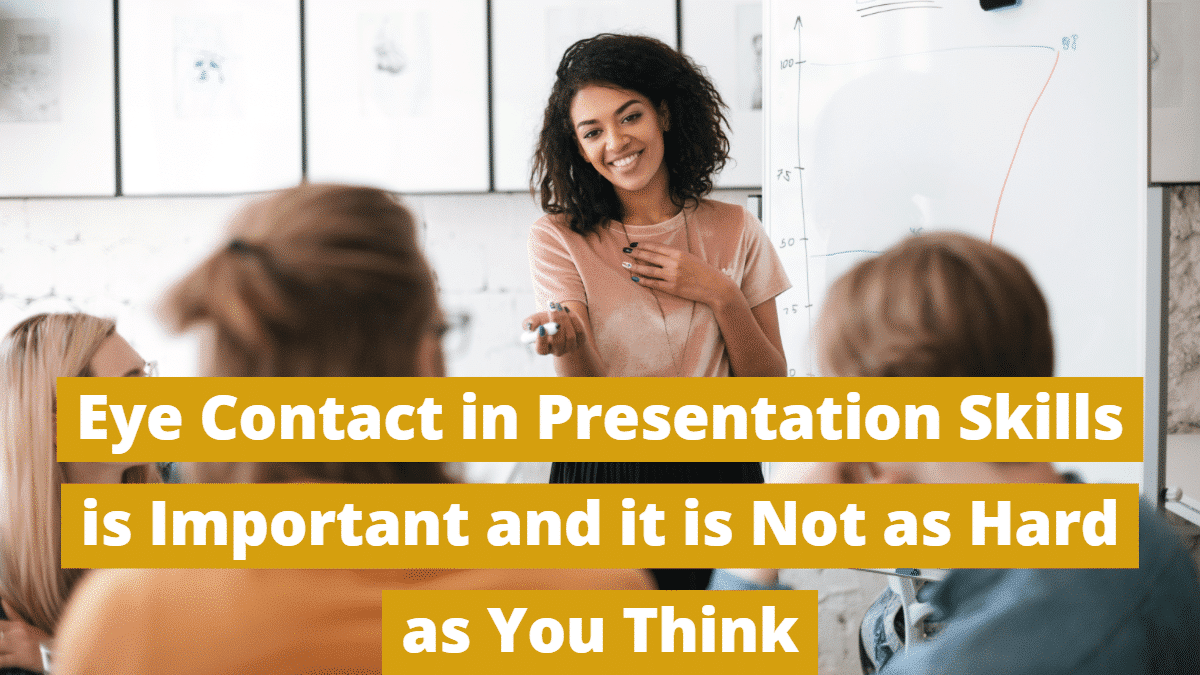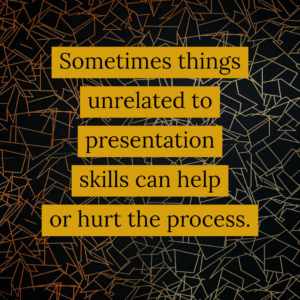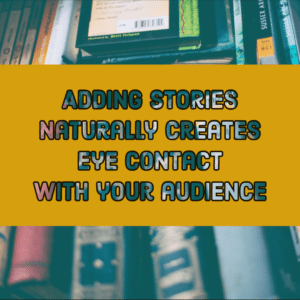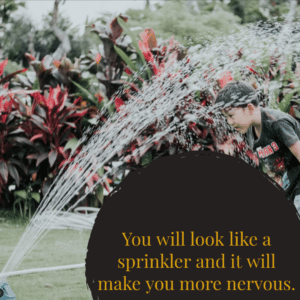
I was teaching the best public speaking course ever last month. Early in the program, I asked the class members, “What physically happens to people when they get nervous in front of a group?” One of the first answers was, “They lose eye contact with the audience.” My response to the class member was, “Yes, eye contact in presentation skills is important, but keeping great eye contact isn’t as hard as what you might think.” Lack of eye contact is a symptom of presentation nervousness. So, when you reduce nervousness, the symptom almost always automatically go away.
Below are a few things that we do in our presentation classes to help participants improve eye contact.
How to Improve Eye Contact When Delivering Presentations
1) Stand Up and Make Yourself the Center of the Presentation.
When people are nervous or self-conscious, they will do things to minimize the threat. However, many of these things will actually make your nervousness worse. For instance, if I feel nervous, I will often just stay seated when I present and make my slideshow the center of the presentation. This is the fatal flaw that causes eye contact in presentation skills to falter.
Your audience will now be looking at your slide the whole time. You will also be looking at your slide (or worse, your computer screen). This is the number one thing that leads to BORING presentations and a lack of eye contact.
Last month, I spoke at a conference in Miami. I was just one of many speakers, so the room was already set-up when I got there. The room was long and skinny. If I were setting the room up, I would have set the screen up in a corner of one of the short walls. I would have then set the tables and chairs facing the short wall. Picture the audience being in a tunnel. If I want everyone to see me and for me to see everyone, I can do that easier from the mouth of the tunnel.
This room, however, was set up with the screen in the very center of the room in the middle of the long wall. Picture a movie theater with only two rows of seats. So, anytime I used a visual aid on the screen, I had to move to the side where over half of the audience could no longer see me. (I couldn’t see them either.)
My point is that when we talk about eye contact in presentation skills, sometimes things unrelated to presentation skills can help or hurt the process. Set your room up properly to make eye contact easier.
2) Insert More Stories and Examples into Your Presentations.
It is almost impossible to tell a good story without looking at your audience in the eye.  Think about the last time you were at dinner with friends or had friends over to your house. At some point, you probably told your friends about something funny or important that happened recently. In your head, go back to that moment. Remember how you looked into the eye of the friend you started telling the story to. Then, as you progressed through the story, you looked briefly at the other people at the table. You were likely looking for visual feedback that your friends were enjoying the story. This is very natural and common.
Think about the last time you were at dinner with friends or had friends over to your house. At some point, you probably told your friends about something funny or important that happened recently. In your head, go back to that moment. Remember how you looked into the eye of the friend you started telling the story to. Then, as you progressed through the story, you looked briefly at the other people at the table. You were likely looking for visual feedback that your friends were enjoying the story. This is very natural and common.
When you add stories into your speeches, you will naturally create great eye contact in presentation skills.
For more details, see How to Tell Stories in Your Presentations.
3) Look for Friendly Faces One-at-a-Time.
One of the first nervousness reduction techniques that we teach in class is to look for a friendly face. Yes, in many audiences, as you look around the room, you see stoic faces. Those faces are hard to keep eye contact with. However, when you say something that a single person in the audience agrees with, he or she will likely nod subtly. When you see this action, your confidence will increase a little. Maintain eye contact with the person for a few seconds. The person will likely smile and nod a little more.
Next, just look around the room for another slight nod and repeat the process.
4) Avoid Unnatural, Forced Techniques Designed to Improve Eye Contact in Presentation Skills.
There are a lot of crazy tips to improve eye contact. Most of them don’t work. For instance, I once had a public speaking teacher in college who suggested that we make eye contact with the entire audience. She said to look at the person farthest to the left and make eye contact for a split second. Then move to the person immediately to the right of that person. Make eye contact for a split second. Continue until you have made eye contact with every single person. Then, start over.
I used to laughingly call this the “sprinkler effect.” If you have ever seen someone do this, the person looks like a lawn sprinkler. Chik… chik… chik… chik… chik… chik… chik… chik… zoooort… chik… chik… chik… chik…
Don’t do this. You will look silly and make yourself more nervous.
5) Get a Good Speaking Coach or Take a Public Speaking Class
If you really struggle with keeping good eye contact with your audience, and you want to fix it, get a coach. One of the reasons why our students tell us that Fearless Presentations ® is a top public speaking class is that our coaches help them fix this challenge.
For instance, a technique that we use is what we call the “mirroring technique.” The presentation coach will stand at the back of the room as a class member speaks at the front of the room. The coach is behind the audience, so the people watching the presentation can’t actually see the coach as he or she coaches the presenter. The coach will sometimes make a subtly gesture with her hand toward a friendly face in the audience. Of course, the person speaking will see this and wonder what the coach is referring to. The presenter will naturally look that direction.
Subtly coaching from the back of the room can help presenters create new habits as they speak. The technique works really well and increases confidence pretty dramatically when done well.
Improve Your Eye Contact in Presentations in Just Two-Days!
If you want access to a world-class public speaking coach at a fraction of the price of one-on-one coaching, the Fearless Presentations ® class can really help! Complete the form below for details.
